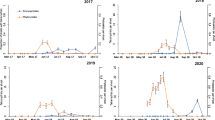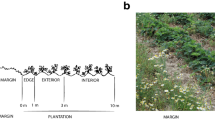Abstract
In two adjacent Japanese pear orchards (orchards 1 and 2), we studied the seasonal occurrence of the Kanzawa spider mite, Tetranychus kanzawai, and its predators. Also the response of these predators to the volatiles from kidney bean plants infested with T. kanzawai was investigated using trap boxes in orchard 1. The mite density in orchard 1 was unimodal, with one peak at the end of August. In this orchard, population development of the specialist insect predators, Scolothrips takahashii, Oligota kashmirica benefica and Stethorus japonicus, was almost synchronized with that of the spider mites. These predators disappeared when the density of their prey became very low in mid-September. Both S. takahashii and O. kashmirica benefica abruptly increased in number in orchard 2 when the spider mite population in orchard 1 decreased. These results suggested that some of the predators migrated from orchard 1 to orchard 2. In this period, predator-traps with T. kanzawai-infested bean plants attracted significantly more S. takahashii than traps with uninfested plants. Very few individuals of S. japonicus and O. kashimirica benefica were found in the traps, despite their abundance in orchard 1. The generalist insect predator, Orius sp., was attracted to the traps throughout the experimental period irrespective of the density of spider mites, although this predator was never observed inside the orchards.
Similar content being viewed by others
References
Dicke, M. 1988. Prey preferences of the phytoseiid mite Typhlodromus pyri 1. Response to volatile kairomones. Exp. Appl. Acarol. 4: 1–13.
Dicke, M. andGroeneveld, A. 1986. Hierarchical structure in kairomone preference of the predatory mite Amblyseius potentillae: dietary component indispensable for diapause induction affects prey location behavior. Ecol. Entomol. 11: 131–138.
Dicke, M. andSabelis, M.W. 1988. How plants obtain predatory mites as bodyguards. Neth. J. Zool. 38: 148–165.
Dicke, M. andVet, L.E. M. 1999. Plant-carnivore interactions: evolutionary and ecological consequences for plant, herbivore and carnivore. In: Herbivores: Between Plants and Predators, H. Olff,V.K. Brown andR.H. Drent (eds.), pp. 483–520. Blackwell Science, Oxford.
Dicke, M.,Sabelis, M.W. andGroeneveld, A. 1986. Vitamin deficiency modified response of predatory mite Amblyseius potentillae to volatile kairomone of two-spotted spider mite. J. Chem. Ecol. 12: 1389–1396.
Dicke, M.,Sabelis, M.W. andde Jong, M. 1988. Analysis of prey preference of phytoseiid mites as determined with an olfactometer, predation models and electrophoresis. Exp. Appl. Acarol. 5: 225–241.
Dicke, M.,Sabelis, M.W.,Takabayashi, J.,Bruin, J. andPosthumus, M.A. 1990a. Plant strategies of manipulating predator-prey interactions through allelochemicals: prospects for application in pest control. J. Chem. Ecol. 16: 3091–3118.
Dicke, M.,Beek, T.A.van, Posthumus, M.A.,Ben Dom, N.,van Bokhoven, H. andde Groot, AE. 1990b. Isolation and identification of a volatile kairomone that effects acarine predator-prey interaction: involvement of host plant in its production. J. Chem. Ecol. 16: 381–396.
Drukker, B.,Scutareanu P. andSabelis, M.W. 1995. Do anthocorid predators respond to synomones from Psylla-infested pear trees under field conditions? Entomol. Exp. Appl. 77: 193–203.
Janssen, A. 1999. Plants with spider-mite prey attract more predatory mites than clean plants under greenhouse conditions. Entomol. Exp. Appl. 90: 191–198.
Janssen, A.,Hofker, C.D.,Braun, A.R.,Mesa, N.,Sabelis, M.W. andBellotti, A.C. 1990. Preselecting predatory mites for biological control: the use of an olfactometer. Bull. Entomol. Res. 80: 177–181.
Maeda, T.,Takabayashi, J.,Yano, S. andTakafuji, A. 1999. Response of the predatory mite Amblyseius womersleyi (Acari: Phytoseiidae), toward herbivore-induced plant volatiles: variation in response between two local populations. Appl. Entomol. Zool. 34: 449–454.
Readshaw, J.L. 1975. The ecology of tetranychid mites in Australian orchards. J. Appl. Ecol. 12: 473–495.
Sabelis, M.W. andvan de Baan, H.E. 1983. Location of distant spider mite colonies by phytoseiid predators: demonstration of specific kairomones emitted by Tetranychus urticae and Panonychus ulmi. Entomol. Exp. Appl. 33: 303–314.
Sabelis, M.W. andvan der Weel, J.J. 1993. Anemotactic responses of the predatory mite, Phytoseiulus persimilis Athias-Henriot, and their role in prey finding. Exp. Appl. Acarol. 17: 521–529.
Sabelis, M.W. andAfman, B.P. 1994. Synomone-induced suppression of take-off in the phytoseiid mite Phytoseiulus persimilis Athias-Henriot. Exp. Appl. Acarol. 18: 711–721.
Sabelis, M.W.,Vermaat, J.E. andGroeneveld, A. 1984. Arrestment responses of the predatory mite, Phytoseiulus persimilis, to steep odor gradients of a kairomone. Physiol. Entomol. 9: 437–446.
Shimoda, T. andAshihara, W. 1996. Seasonal population trends of spider mites and their insect predator, Oligota kashmirica benefica Naomi (Coleoptera: Staphylinidae), in Satsuma mandarin groves and in Japanese cedar windbreaks around the orchards. Proc. Assoc. Plant Protection of Kyushu 42: 133–137 (in Japanese).
Shimoda, T.,Takabayashi, J.,Ashihara, W. andTakafuji, A. 1997. Response of predatory insect Scolothrips takahashii toward herbivore-induced plant volatiles under laboratory and field conditions. J. Chem. Ecol. 23: 2033–2048.
Takabayashi, J. andDicke, M. 1996. Plant-carnivore mutualism through herbivore-induced carnivore attractants. Trends Plant Sci. 1: 109–113.
Venzon, M.,Janssen, A. andSabelis, M.W. 1999. Attraction of a generalist predator towards herbivore-infested plants. Entomol. Exp. Appl. 93: 305–314.
Vet, L.E.M. andDicke, M. 1992. Ecology of infochemical use by natural enemies in a tritrophic context. Annu. Rev. Entomol. 37: 141–172.
Author information
Authors and Affiliations
Rights and permissions
About this article
Cite this article
Takahashi, H., Takafuji, A., Takabayashi, J. et al. Seasonal occurrence of specialist and generalist insect predators of spider mites and their response to volatiles from spider-mite-infested plants in Japanese pear orchards. Exp Appl Acarol 25, 393–402 (2001). https://doi.org/10.1023/A:1017997110721
Issue Date:
DOI: https://doi.org/10.1023/A:1017997110721




